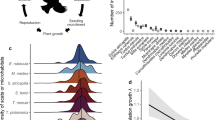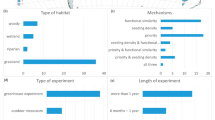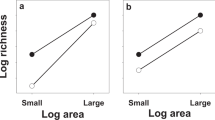Abstract
Seed-dispersal mutualisms have a fundamental role in regenerating natural communities1,2. Interest in the importance of seed dispersal to plant communities has been heightened by worldwide declines in animal dispersers3,4,5. One view, the ‘keystone mutualist hypothesis’, predicts that these human-caused losses will trigger a cascade of linked extinctions throughout the community6. Implicitly, this view holds that mutualisms, such as seed dispersal, are crucial ecological interactions that maintain the structure and diversity of natural communities. Although many studies suggest the importance of mutualism3,7, empirical evidence for community-level impacts of mutualists has remained anecdotal8,9, and the central role of mutualism, relative to other species interactions, has long been debated in the theoretical literature10,11. Here I report the community-level consequences of a biological invasion that disrupts important seed-dispersal mutualisms. I show that invasion of South African shrublands by the Argentine ant (Linepithema humile) leads to a shift in composition of the plant community, owing to a disproportionate reduction in the densities of large-seeded plants. This study suggests that the preservation of mutualistic interactions may be essential for maintaining natural communities.
This is a preview of subscription content, access via your institution
Access options
Subscribe to this journal
Receive 51 print issues and online access
$199.00 per year
only $3.90 per issue
Buy this article
- Purchase on Springer Link
- Instant access to full article PDF
Prices may be subject to local taxes which are calculated during checkout





Similar content being viewed by others
References
Howe, H. F. & Smallwood, J. Ecology of seed dispersal. Ann. Rev. Eco. Syst. 13, 201–228 (1982).
Chapman, C. A. Primate seed dispersal; coevolution and conservation implications. Evol. Anthropol. 4, 74–82 (1995)).
Cox, P. A., Elmquist, T., Pierson, E. D. & Rainey, W. E. Flying foxes as strong interactors in South Pacific island ecosystems: a conservation hypothesis. Conserv. Biol. 5, 448–454 (1991).
Chapman, C. A. & Chapman, L. J. Survival without dispersers: seedling recruitment under parents. Conserv. Biol. 9, 675–678 (1995).
Aparecida Lopez, M. & Ferrari, S. F. Effects of human colonization on the abundance and diversity of mammals in eastern Brazilian Amazonia. Conserv. Biol. 14, 1658–1665 (2000).
Gilbert, L. E. in Conservation Biology: An Evolutionary–Ecological Perspective (eds Soule, M. E. & Wilcox, B. A.) 11–33 (Sinauer, Sunderland, 1980).
Bond, W. J. Do mutualisms matter? Assessing the impact of pollinator and disperser disruption on plant extinction. Phil. Trans. R. Soc. Lond. B 344, 83–90 (1994).
Mills, L. S., Soule, M. E. & Doak, D. F. The keystone-species concept in ecology and conservation. Bioscience 43, 219–224 (1993).
Power, M. E. et al. Challenges in the quest for keystones. Bioscience 46, 609–620 (1996).
May, R. M. in Theoretical Ecology, Principles and Applications (ed. May, R. M.) 49–70 (Saunders, Philadelphia, 1976).
Addicott, J. F. in A New Ecology: Novel Approaches to Interactive Systems (eds Price, P. W., Slobodchikoff, C. N. & Gaud, W. S.) 437–455 (Wiley, New York, 1984).
de Kock, A. E. & Giliomee, J. H. A survey of the Argentine ant, Iridomyrmex humilis (Mayr) (Hymenoptera: Formicidae) in South African fynbos. J. Entomol. Soc. S. Africa 52, 151–164 (1989).
Bond, W. J., Yeaton, R. & Stock, W. D. in Ant–Plant Interactions (eds Huxley, C. & Cutler, D.) 448–462 (Oxford Univ. Press, Oxford, 1991).
Bond, W. J. & Slingsby, P. Collapse of an ant–plant mutualism: the Argentine ant (Iridomyrmex humilis) and myrmecochorous Proteaceae. Ecology 65, 1031–1037 (1984).
Cole, F. R., Medeiros, A. C., Loope, L. L. & Zuehlke, W. W. Effects of the Argentine ant on arthropod fauna of Hawaiian high-elevation shrubland. Ecology 73, 1313–1322 (1992).
Ward, P. S. Distribution of the introduced Argentine ant (Iridomyrmex humilis) in natural habitats of the lower Sacramento Valley and its effects on the indigenous ant fauna. Hilgardia 55, 1–16 (1987).
Way, M. J., Cammell, M. E., Paiva, M. R. & Collingwood, C. A. Distribution and dynamics of the Argentine ant Linepithema (Iridomyrmex) humile (Mayr) in relation to vegetation, soil conditions, topography and native ant competitor ants in Portugal. Insectes Sociaux 44, 415–433 (1997).
De Kock, A. E., Giliomee, J. H., Pringle, K. L. & Majer, J. D. in Fire in South African Mountain Fynbos (eds van Wilgen, B. W., Richardson, D. M., Kruger, F. J. & van Hensbergen, H. J.) 201–215 (Springer, Berlin, 1992).
Lawton, J. H. & Brown, V. K. in Biodiversity and Ecosystem Function (eds Schulze, E.-D. & Mooney, H. A.) 255–270 (Springer, Berlin, 1993).
Cushman, J. H. in Islands: Biological Diversity and Ecosystem Function (eds Vitousik, P. M., Loope, L. L. & Adsersen, H.) 135–147 (Springer, Berlin, 1995).
Brown, J. H. & Henske, E. J. Control of a desert–grassland transition by a keystone rodent guild. Science 250, 1705–1707 (1990).
Howe, H. F. Specialized and generalized dispersal systems: where does the ‘the paradigm’ stand? Vegetatio 107/108, 3–13 (1993).
Hughes, L. et al. Predicting dispersal spectra: a minimal set of hypotheses based on plant attributes. J. Ecol. 82, 933–950 (1994).
Slingsby, P. & Bond, W. Ants—friends of the Fynbos: Mimetes hirtus, dispersal and storage by ants. Veld Flora 67, 39–45 (1981).
Visser, D., Wright, M. G. & Giliomee, J. H. The effect of the Argentine ant, Linepithema humile (Mayr) (Hymenoptera: Formicidae), on flower-visiting insects of Protea nitida Mill. (Proteaceae). Afr. Entomol. 4, 285–287 (1996).
Witt, A. B. R. Factors affecting Myrmecochory in Fynbos. (Thesis, Univ. Stellenbosch, 1993).
Hölldobler, B. & Wilson, E. O. The Ants (Harvard Univ. Press, Cambridge, 1990).
Passera, L. in Exotic ants: Biology, Impact, and Control of Introduced Species (ed. Williams, D. H.) 23–43 (Westview, Boulder, 1994).
Slingsby, P. & Bond, W. J. The influence of ants on the dispersal distance and seedling recruitment of Leucospermum conocarpodendron (L.) Buek (Proteaceae). S. Afr. J. Bot. 51, 30–34 (1985).
Bond, W. J. & Breytenbach, G. J. Ants, rodents and seed predation in Proteaceae. S. Afr. J. Zool. 20, 150–154 (1985).
Acknowledgements
Comments from A. Agrawal, E. Baack, E. Bruna, H. Cushman, A. Pauw, J. Rudgers, M. Stanton, S. Strauss and H. Robertson improved this manuscript. I thank E. Baack, W. Bond, D. Doak, M. and A. Johns, and P. Ward for their assistance and discussions during this project. Cape Nature Conservation and the South African Museum also provided support. This work was supported by grants from the National Science Foundation, Achievement Rewards for College Scientists Foundation, and the Center for Population Biology, UC Davis.
Author information
Authors and Affiliations
Corresponding author
Rights and permissions
About this article
Cite this article
Christian, C. Consequences of a biological invasion reveal the importance of mutualism for plant communities. Nature 413, 635–639 (2001). https://doi.org/10.1038/35098093
Received:
Accepted:
Issue Date:
DOI: https://doi.org/10.1038/35098093
This article is cited by
-
The variability of iridomyrmecin, the venom of the Argentine ant, in its native and invasive ranges
Chemoecology (2023)
-
Introduced galliforms as seed predators and dispersers in Hawaiian forests
Biological Invasions (2022)
-
Uncovering how behavioral variation underlying mutualist partner quality is partitioned within a species complex of keystone seed-dispersing ants
Insectes Sociaux (2022)
-
Native and invasive ants affect floral visits of pollinating honey bees in pumpkin flowers (Cucurbita maxima)
Scientific Reports (2021)
-
Effects of Biochar Application on Soil Organic Carbon in Degraded Saline-sodic Wetlands of Songnen Plain, Northeast China
Chinese Geographical Science (2021)
Comments
By submitting a comment you agree to abide by our Terms and Community Guidelines. If you find something abusive or that does not comply with our terms or guidelines please flag it as inappropriate.



